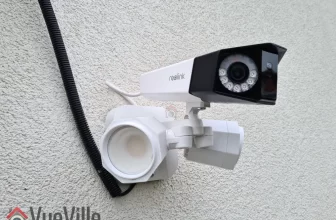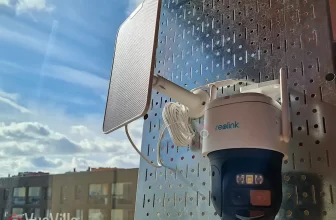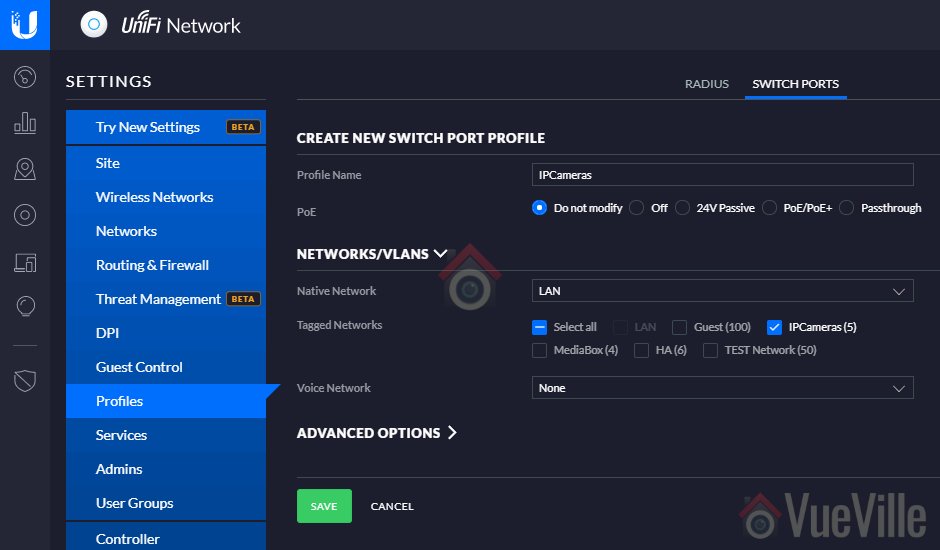Recently a reader asked me how the Reolink cameras compare to the Lorex and Swann ones. A lot has changed with Lorex recently, so let’s look at that comparison first.
Until 2020, Lorex cameras were intended to be used only with their own NVRs. In other words, you were not allowed to venture outside their ecosystem. This was totally against the ethos of openness and inter-operability that I champion here at VueVille. That’s why I never recommended them in our outdoor and indoor IP camera roundups.
But in late 2020, Lorex released the latest version of their IP cameras and surprise surprise, they now support ONVIF Profile S. Dahua acquiring Lorex from FLIR) in 2018 seems to have triggered this happy development. Of course, Lorex cameras are rebranded Dahuas so they were always capable of it.
Sadly that didn’t last long. Recent Lorex cameras do not have ONVIF or RTSP support anymore (datasheets and Lorex Q&A confirm this). In November 2022, Dahua announced that it is selling Lorex to Skywatch, a privately held cloud services company in Taiwan.
For this comparison I have picked the most popular and affordable 8 Megapixel 4K-capable models from both brands – Reolink RLC-810A and the comparable Lorex E892ABW.
A quick note: As an Amazon Associate I earn from qualifying purchases. This post contains affiliate link(s). An affiliate link means I may earn advertising or referral fees if you make a purchase through my link, at no extra cost to you.
Reolink vs. Lorex – the Stories behind the Brands

Reolink
Reolink is a popular brand that is only a few years old. But they are not exactly new to the surveillance camera industry. The brand Reolink is owned by Reolink Innovation Limited (earlier known as Shenzhen Baichuan Security Technology Co., Ltd.) who are a manufacturer of security cameras and other surveillance equipment. What’s the source? I simply emailed them and asked. Simple as that.
So Reolink is not a rebranded Hikvision or Dahua as some have claimed online. Therefore they are not subject to the Federal government ban imposed through the National Defense Authorization Act (NDAA). This is a huge positive for Reolink.
Lorex
Lorex was founded in 1993 and has head offices in Markham, Ontario, Canada and in Linthicum, Maryland, USA. They have product warehouses in Markham, Indiana and California.
But first let’s start with the company FLIR, better known as the high-end camera manufacturer who revolutionized thermal imaging for the military and industrial markets. They acquired Lorex in 2012 for around $60 million seeking to lower the cost of thermal imaging and open it up to the retail market.
So for the next 6 years they tried to penetrate the DIY and SMB markets. During this period, their main OEM supplier was Dahua. In February 2018, however, FLIR exited the DIY security camera space by selling Lorex to Dahua. Until November 2022, they operated as a subsidiary of Dahua. So effectively, Lorex was a Dahua brand between February 2018 and November 2022.
As mentioned in my intro above, Dahua has now sold Lorex to Skytech, a Taiwanese cloud services company. The disappearance of ONVIF and RTSP support from recent Lorex models is probably a sign of things to come.
8MP 4K IP Camera Duel – Reolink RLC-810A vs. Lorex E892ABW
Right off the bat, I need to point out that the biggest difference between Reolink and Lorex is that Reolink cameras can work either in standalone mode or with Reolink NVRs, or even any NVR that is ONVIF compliant.
But Lorex cameras will work only with Lorex NVRs and that too select Lorex NVRs. In other words, Lorex cameras work only within the Lorex eco-system.
This is the polar opposite of the Reolink cameras which will work with any 3rd party ONVIF/RTSP compliant system. Okay, now that’s out of the way, let’s get into the details.
Hardware features
The Reolink RLC-810A has a 1/2.5″ sensor, that’s slightly larger than the Lorex’s 1/2.8″ sensor.
The size of the sensor has a huge bearing on the low light ability of a camera, whether it be a camcorder or a security camera. The larger the sensor, the greater its ability to gather light and so do well in low light conditions. But as you cram in more and more pixels into the same size sensor, they get smaller and smaller, which adds noise. Noise is the bane of low light video and reduces the detail that you can get out of your video. So while security camera manufacturers have pushed pixel count from 8 Megapixels and beyond, the sensor size has not always kept up. Kudos to Reolink for bucking the trend here.
Next up is WDR or Wide Dynamic Range. This is a feature that enhances the level of detail an IP camera can pick out in shadows. Unfortunately neither camera supports WDR. Not entirely surprising given the budget nature of these brands. However Lorex claims to support true HDR but does not provide any further details about it.
While most cameras are good in daylight, decent night-time performance is tricky to achieve. Neither Reolink nor Lorex specify a lux rating without InfraRed (IR) illumination. Okay but how do they work in low light? Both cameras have an automatic IR cut filter that will switch to black and white infrared vision when it gets dark. So far, that’s standard IP camera behaviour.
However, Lorex claims a ‘colour night vision’ feature whereby you still get colour video under low light conditions. So this feature still requires external illumination. So I fail to see how this is something special – the Reolink has a larger sensor and probably even better low light colour vision ability! I see this so-called feature as a marketing gimmick and nothing more.
What about the Lorex’s LED lights though? They look like LED spotlights that you can leave permanently on through the night, but actually they are only warning LEDs that are motion-activated or activated on-demand in the mobile app. If these lights were at least proper spotlights, then the colour night vision claim would make more sense (Reolink has such models).
The Lorex has 2-way audio using an onboard microphone and speaker combo, with the speaker doubling up as a siren deterrent. This particular Reolink gets only a microphone.
Both cameras have on-board SD card for local storage of video clips and snapshots.
Winner: Reolink
Software features
The three software features that make a great IP camera are ONVIF/RTSP support, built-in NVR feature, and the advanced motion detection features that help reduce false alerts.
Only the Reolink supports ONVIF & RTSP. While ONVIF/RTSP is conspicuously absent from Reolink’s spec sheets and their marketing material, Reolink has confirmed that their non-battery powered IP cameras do have ONVIF and RTSP support.
Lorex has recently removed all mentions of ONVIF support on their product pages (their datasheets never mentioned it anyway). Lorex has also confirmed in their website Q&A section that this camera doesn’t support ONVIF.
Why is ONVIF support important? ONVIF support ensures that your camera will work with ONVIF-compliant equipment from 3rd party manufacturers. This is why you can add a Reolink camera to your ONVIF-compatible NVR or DIY NAS NVR.
RTSP allows even non-ONVIF equipment (such as software) to access the security camera’s video stream. Examples are video players like the popular VLC player, and Blue Iris PC NVR software.
Both Reolink and Lorex have on-board storage but only Reolink cameras have the built-in NVR feature – because Reolink cameras are designed for standalone operation (don’t need an NVR).
The Reolink IP cameras can all do basic motion detection, smart motion detection (person/vehicle/pet) and can send email/push alerts. The Lorex cameras cannot do any of this on its own. It is just an IP camera with no smart features unless its connected to an NVR. More on that later.
Motion Detection ability
I classify motion detection ability into three:
- Basic motion detection – this is detecting just simple pixel changes, results in false alerts.
- Advanced motion detection – like line crossing, intrusion detection, which result in fewer false alerts.
- Smart detection – person / face / vehicle / pet detection, the best method for eliminating false alerts.
Both Reolink and Lorex IP cameras support basic and smart motion detection methods. But as mentioned earlier, the Reolink is capable of standalone operation. It can record motion detection triggered clips, take snapshots, and send out email alerts and push notifications to the Reolink app on mobile devices without an NVR or PC.
The Lorex can do none of this by itself, you have to buy a compatible Lorex NVR for that.
Winner: Reolink
Warranty
Reolink IP cameras come with a limited 2-Year warranty as standard. Lorex has a 2 year warranty as standard, but can be extended to 3 years or 5 years for an extra fee.
Detailed Comparison Table
Here’s a summary in a nice and easy table:
| Feature | Reolink RLC-810A | Lorex E892ABW |
|---|---|---|
| Hardware features | ||
| Sensor | 1/2.5" 8 MP (4K) CMOS Sensor | 1/2.8" 8 MP (4K) CMOS Sensor |
| WDR | No | No, but supports HDR |
| Night Vision | 850 nm IR, Black & white night vision, IR cut filter with auto switch | Black and white night vision, IR cut filter with auto switch, Colour night vision |
| Colour Night Vision | No | Using external lighting or built-in LED warning light |
| LED spotlight | No | |
| LED warning light | No | Turns on only when motion is detected / on-demand in app. Cannot be permanently on at night. |
| Lens Type | Fixed type | |
| Lens | 2.8mm @ F=2.0 | |
| Lens Field of View (FOV) | Horizontal: 101° Vertical: 42° | Horizontal: 108° |
| Siren | No | Yes |
| IR Range | 30 m (98 feet) | |
| Minimum illumination | B&W: 0Lux with IR on | N/A |
| Longest dimension | 192 mm | 184 mm |
| Metallic housing | Yes | |
| Ingress Protection | IP66 | IP67 |
| Vandal resistance | No | |
| DC 12V power | Yes | |
| Operating conditions | -10°C to +55°C (14°F to 131°F), Humidity: 10% to 90% | -30°C to 60°C (-22°F to 140°F), Humidity: <95% |
| Power usage | <12 W (with IR ON) | < 9.5W (with IR ON) |
| Interfaces | Reolink RLC-810A | Lorex E892ABW |
| SD Card | Yes | |
| Audio support | Microphone only | 2-way audio using microphone and speaker |
| PoE | Yes, 802.3af | |
| Wi-Fi | No | |
| Alarm in/out | No | |
| Software features | Reolink RLC-810A | Lorex E892ABW |
| Stand-alone operation (without NVR) | Yes | No |
| ONVIF, RTSP | Yes | No |
| Encoding | H.265/MJPEG | H.265/H.264H/MJPEG |
| Max Resolution | 3840 × 2160 (8MP) @ 25 fps | 3840 × 2160 (8MP) @ 15 fps |
| Bitrate | 64 Kbps to 8 Mbps | N/A |
| Simultaneous streams | 12 simultaneous video streams (10 sub-streams & 2 main streams) | N/A |
| 3D Noise Reduction | Yes | |
| Built-in NVR | Yes | No |
| Network storage | NAS, FTP, Local PC | N/A |
| Alert events | Reolink RLC-810A | Lorex E892ABW |
| Cloud-reliant? | No | |
| Email alerts | Yes | No standalone operation, requires NVR |
| Push alerts | Yes | No standalone operation, requires NVR |
| Simple motion detection | Yes | Yes - requires compatible Lorex NVR |
| Person detection | Yes | Yes - requires compatible Lorex NVR |
| Face detection | No | Yes - requires compatible Lorex NVR |
| Vehicle detection | Yes | Yes - requires compatible Lorex NVR |
| Pet detection | Yes (in beta status) | No |
| Audio Detection | No | Yes - requires compatible Lorex NVR |
| Line crossing detection | No | |
| Intrusion detection | No | |
| Abandoned/Missing object detection | No | Yes - requires compatible Lorex NVR |
| Scene change detection | No | |
| Where to buy | ||
Verdict – Reolink vs. Lorex
Reolink is the clear choice for DIY security camera enthusiasts because Lorex has regressed in the core feature set (ONVIF and RTSP support removed). Reolink cameras are also capable of standalone operation thanks to the built-in NVR functionality. If you would like to research more about IP cameras, do check out the other recommendations on my best outdoor and indoor IP cameras list.
Where to buy
- Reolink RLC-810A at Amazon or Reolink.com
- Lorex E892ABW at Amazon






I have a wireless 4 cam lorex with a hub and I also have a wired 8 cam reolink with an nvr. Reolink wins out, BY FAR bc the lorex has a mind of its own. It will record someone walking in one direction but not record when they walk back? How is that even possible? Reolink doesn’t miss a thing either way. Perhaps I’m being interrupted on the lorex? It doesn’t make sense to me, but reolink is the clear winner in my book.
I agree and that’s my verdict as well. Although I’d say that wireless is always going to be a bit flaky compared to wired, that’s just how it is – nothing beats a wired connection!
Do you know what chipset is used in Reolink products? If they use chips from Huawei, they would still not be NDAA compliant.
Good point, I will have to open up one of my Reolinks and check.
Nice review. The paragraph starting with “The size of the sensor has a huge bearing on the low light ability of a camera” is duplicated. So Reolink makes their own hardware?
Good spot! Thanks I have fixed it now. Yes Reolink makes their own hardware, Reolink is the retail brand owned by Reolink Innovation Limited (which used to be known until recently as Shenzhen Baichuan Security Technology Co., Ltd. – they have been making their own hardware for a long time).
So I need to hook up 5 cameras. As I understand, the 5 cables will go to my POE switch, then via one wire will route to the NVR. My question is: Given the 5 cables to the 8 port POE switch, is this going to create a major data bottle neck? If yes, how to address this.
Should I wire each of the individual cameras to the NVR. For me I can do this but it will result in a larger hole that I have to make in walls etc. Is there another solution or method. Any help is appreciated.